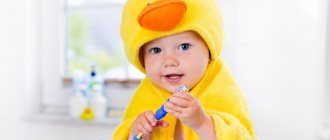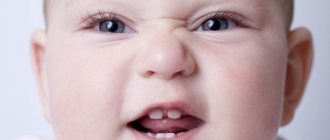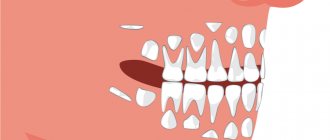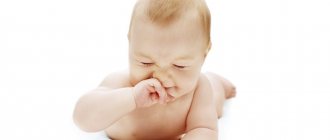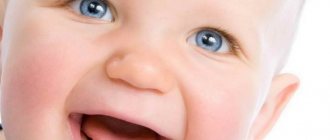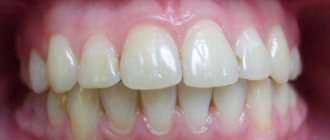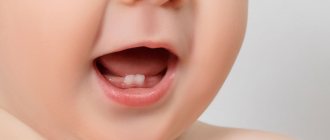The order of eruption of baby teeth.
The first teeth that a child begins to erupt at the age of 5 - 8 months on the lower jaw are the deciduous incisors. Next, the central primary incisors on the upper jaw begin to appear. At the age of 9 - 13 months, the lateral incisors on the upper and lower jaws erupt. At the age of 13 - 19 months, the first chewing teeth (first primary molars) are cut on the upper and lower jaws. A gap is formed between the lateral incisors and molars, during which the primary canine begins to erupt at 16 months. The last to begin to emerge is the second chewing tooth (second primary molar), first on the lower jaw, then on the upper jaw. By age 3, a full set of baby teeth should have formed.
What are baby teeth and how do they erupt?
Temporary teeth are colloquially called baby teeth because they begin to appear when the baby is still breastfed. The rudiments of dental elements are formed during intrauterine development (6–8 weeks of pregnancy). Eruption is the process of teeth emerging onto the gum surface. Mechanism: the tooth root develops, over time it begins to rest against the hard bone tissue of the bottom of the alveoli, pushing the crown part of the tooth onto the surface of the gum. In total, 20 elements appear in the primary occlusion, 10 on each jaw.
Features of the period and symptoms of the eruption of the first teeth.
DATES OF TEETHING ARE INDIVIDUAL FOR EACH BABY AND DEPEND ON A NUMBER OF FACTORS: NUTRITION, HEREDITY, ETC. THIS IS WHY YOU SHOULD NOT WORRY MUCH IF THE LONG AWAITED APPEARANCE OF YOUR FIRST TEETH IS DELAYED.
PHOTO: Gums of a child at 6 months. Before the first baby teeth erupt, the gums in the area of the future teeth turn slightly white due to tooth pressure.
It's hard to miss when children's first teeth appear. As the tooth erupts, it “tightens” the mucous membrane (the tooth can be felt with your finger under the mucous membrane) and, having “broken through” it, ends up in the oral cavity. In some children, a bluish “bump” or “ball” with transparent contents forms on the mucous membrane above the erupting tooth. This is a small eruption cyst that usually breaks out on its own WITHOUT outside help (despite the menacing name), although sometimes the intervention of a pediatric dentist is required.
The first teeth that appear may be located asymmetrically and “not evenly” - this is the norm. Such dental disorder has the right to exist until the eruption of 16 teeth: baby teeth are independently ordered as they erupt, aligning each other. This is facilitated by the intake of solid food, pressure of the tongue and lip muscles.
In a normal primary occlusion, gaps form between the primary incisors and canines (on average 1 mm), which is normal and a sign that the permanent wider incisors will have enough space in the dentition during the period of physiological change of teeth. The absence of these spaces indicates a lack of space for permanent teeth.
In most cases, teething does not cause the child any discomfort, although sometimes the process of teething can be accompanied by “itching” of the gums and lead to sleep disturbances in the child, causing a lot of trouble for the child and his parents.
Teeth are cutting!
A seven-month-old child has a fever, his nose is running, he refuses to eat... Is it really ARVI again? After all, you just recently got sick? Or maybe the child isn’t sick after all? But then where do these symptoms, typical of colds, come from?
You can read about the symptoms of ARVI in children here
Today, with Valeria Aleksandrovna Golovko, a pediatrician at Clinic Expert Tula LLC, we are talking about long-awaited teeth. How many months does the first tooth appear? What accompanies their appearance? Our article is about this and much more.
- The first thing parents expect from a child is a smile, then his “aha”, but the most exciting expectation is whether the baby will have teeth? When do babies' first teeth start to grow?
According to statistics, the first milk teeth appear on average at 6-8 months of age. As a rule, these are the middle lower incisors.
The onset of teething depends on a number of factors. From which ones exactly?
— heredity or, in other words, the timing of the appearance of teeth in the baby’s parents;
- full-term baby. Premature babies may develop teeth later;
- the child’s nutrition, namely, sufficient intake of calcium into the body (after the start of complementary feeding, the main sources of calcium are cottage cheese and somewhat less - kefir);
— sufficient intake of vitamin D into the body. Its natural sources are egg yolk and butter;
— climatic conditions. Children living in hot climates erupt teeth earlier;
- gender of the child. Girls erupt teeth earlier;
- sometimes a deviation in the period of teeth appearance from the statistical average in one direction or another occurs in situations where a baby has 1-2 teeth immediately after birth. They are usually always defective and quickly fall out or are removed.
- What is the pattern of baby teeth eruption in children?
First, the lower middle incisors appear (simultaneously or in turn). Then 4 upper incisors erupt, and then 2 lower lateral ones. On average, a baby has 8 teeth by the age of one year.
After this, the molars (premolar teeth) are cut. The lower anteriors appear somewhat earlier (at 12-18 months), and the upper anteriors appear later (at 13-19 months).
Then the rear molars appear: the lower ones - from 20 to 31 months, and the upper ones - from 16 to 22 months.
Canines: lower - from 16 to 23 months, and upper - from 16 to 22 months.
Those. By the age of 3, a child has 20 primary teeth, i.e. incisors, canines and molars.
Individual differences should also be kept in mind, i.e. this number of teeth can be at 2 or 2.5 years.
- Let's talk about the first signs of teeth appearing in a baby. What could they be?
One of the first manifestations is redness and swelling of the gums. Salivation increases. Appetite worsens, up to complete refusal to eat. Irritability increases and sleep is disturbed. The baby asks to be held more often, and physical activity increases. The reason is itching and sore gums.
- What painful symptoms can accompany the appearance of teeth in a child?
This is salivation, nasal congestion and discharge from it. Sometimes there is a cough/cough, stool disturbances in the form of loosening (but maintaining the normal frequency of bowel movements). There may be irritation of the skin of the mouth, chin, chest, i.e. areas where saliva enters. In some cases, the temperature rises: more often not higher than 38.5°C, less often - 39°C and higher, often subsides on the second or third day. The child may become irritable.
Vomiting and diarrhea are less common: in this case, you need to be especially vigilant, since these signs may not be associated with teeth, but indicate some kind of disease - for example, rotavirus infection.
What to do if your child has a stomach ache? The story is told by the surgeon, Deputy Chief Physician for Pediatrics at Clinic Expert Smolensk LLC Alexey Alexandrovich Zakharov
- How to relieve baby's teething pain?
This task is not easy. First of all, it is necessary to ensure that the baby has the opportunity to chew sufficiently. This is what teethers are designed for. Massaging your gums may help.
Gels are also used when teething in children, but their disadvantage is that they can cause an allergic reaction.
There are homeopathic rectal suppositories. According to indications, antipyretic and analgesic syrups can be used.
-Which teethers are best to use?
They must be elastic and durable (and therefore safe). The best ones are silicone, latex, having the appropriate anatomical shape to form the correct bite.
There are also plastic teethers that contain liquid or gel inside. Before use, they are cooled in the refrigerator (at +6°C) and only then given to the child. The additional cold factor also reduces pain to a certain extent. The downside is that these teethers need to be constantly cooled.
A separate advantage of teethers is their positive effect on fine motor skills.
-Can I use carrots, apples or cookies instead of teethers?
In principle, it is possible, but, firstly, these products should already be in the child’s diet; secondly, their use should not begin when the first teeth erupt: at least, all incisors should be present; and thirdly, the child must be able to swallow food well. If you give a teething child an apple, carrot or cookie, you must ensure that the child does not choke.
- How do you feel about using traditional methods to help a child who is teething?
Overall positive, however, only after consulting a doctor. Why? Sometimes, for example, when teething, herbal decoctions are used, but at the same time, one should remember the possibility of allergic reactions.
Is your child suffering from allergies? Ulyana Vladimirovna Chemova, an allergist-immunologist at Clinic Expert Smolensk, tells how to help a baby.
In particular, a decoction of chamomile flowers and a ready-made high-quality aqueous solution of propolis are used.
- Are the first teeth and their appearance a reason to contact a pediatrician or should you go to see him only if something worries you?
Sometimes, under the “mask” of teething, the onset of an infectious disease can be hidden. Therefore, if two or more of the signs that I mentioned earlier are detected, you need to contact your pediatrician.
You can make an appointment with a pediatrician in your city here
- Does teething always affect the general condition of the baby? Or can teeth appear easily and without parents even noticing?
No, the general condition does not always change. In some cases, parents find out about an erupted tooth by catching it with a spoon when feeding the child.
- What is the most important thing when teething? How can parents and their children survive this period calmly?
A universal remedy - double parental affection, attention and care for the baby. Don’t be afraid to pamper your child, carry him in your arms more - this will add calmness to the baby and create a sense of security.
It should be remembered that this period is not very long and, like everything, it too will pass and will later be remembered with a smile.
- The anxiety is over, the first teeth have appeared. How to properly care for them?
As soon as the first tooth appears, you can visit the dentist and begin oral care. There are special silicone brush attachments (put on your finger) that can be used to treat the teeth of even a 6-month-old child. This should be done at least once a day until the age of one year. From the age of one, you can brush your teeth with a very soft toothbrush, moving from the gums to the cutting edge of the tooth or chewing surface.
You might be interested in:
What will help with a cough: badger fat or mustard in socks? We treat children correctly
Your immune system is under control! We create a strong rear for the child
Are unvaccinated children the healthiest?
For reference:
Golovko Valeria Alexandrovna
Graduate of the Faculty of Medicine of Tula State University in 2004.
In 2005, she completed an internship in the specialty “Pediatrics”
Currently working as a pediatrician at Clinic Expert Tula LLC.
Typical problems.
PHOTO: a child’s teeth at 3 years old. Gaps between baby front teeth at age 3 are normal. On the front upper teeth there is caries in the cervical area of the teeth.
There may be a slight rise in body temperature and anxiety in children when their first teeth are cut. This is due to minor inflammation and itching of the gums in the area where teeth are about to erupt. To relieve discomfort, it is recommended to treat the oral cavity with special napkins for oral hygiene, containing special antiseptic and tanning substances.
The most common problem faced by parents aged 12 - 18 months is “bottle” caries, the main cause of which is poor oral hygiene in the child and night feedings. As a result of poor hygiene, a large amount of soft plaque forms on the teeth. Plaque contains a large number of bacteria that produce acid, which “corrodes” the enamel, leading to the formation of caries.
Night feedings at the age of 12 - 18 months create the most favorable conditions for the development of caries, because... At night, saliva production is reduced - the acid of bacteria living in dental plaque is not neutralized.
BREAST-fed children are LESS likely to develop dental caries than bottle-fed children. Breast milk helps saturate the surface of teeth with calcium and phosphate ions. Breast milk contains a large number of immunological protective factors. At the same time, it has been noted that long-term night feeding (both breast and bottle feeding) leads to the development of dental caries, especially in the area of the upper front milk teeth.
PHOTO: A one and a half year old child’s teeth. The front incisors and first molars have erupted. The fang (3rd tooth) is emerging. Often at this age the first injuries occur: the child fell and hit his front upper tooth - the tooth broke.
Against the background of poor hygiene and a weakened immune system, inflammatory diseases of the mucous membrane and stomatitis may develop. Stomatitis in young children is severe, accompanied by general malaise, loss of appetite and increased body temperature.
IT IS VERY IMPORTANT TO START TEACHING YOUR CHILD TO THE NECESSITY OF INDIVIDUAL ORAL HYGIENE FROM THE MOMENT OF THE APPEARANCE OF THE FIRST TEETH. GOOD ORAL HYGIENE IN A CHILD IS THE KEY TO HEALTHY TEETH FROM EARLY CHILDHOOD.
Associated symptoms
These symptoms do not appear very often, but they cannot be ignored. If the baby has a fever, an incomprehensible cough, or diarrhea, this can be either a sign of infection or a reaction of a weakened body to pathogenic microflora.
Diarrhea can be a sign not only of teething, but also of various diseases
When teeth are forming, the temperature usually lasts for 3-4 days at 38.5°C. This symptom is irregular, so fever in children should be periodic. If it persists for a long time, you need to show the child to the pediatrician. Some doctors believe that cold symptoms have nothing to do with teething and prescribe appropriate treatment for cough and fever.
If the temperature lasts longer than three days, you should consult a doctor.
Adults also don’t understand what cough and runny nose have to do with new teeth. The gums are directly connected to the blood supply to the nose and respiratory tract. As teeth form, blood flow increases in the mouth. The nasal mucosa is close, so its glands also begin to produce more mucus, which children try to get rid of. Remaining mucus settles into the throat, irritating the airways and causing a cough.
A runny nose may occur when teething
Another symptom is loose stools with a frequency of no more than 3 times a day. While scratching his gums, the baby constantly puts dirty fingers and the first objects he comes across into his mouth. In addition to infection, diarrhea is facilitated by increased salivation, which constantly flushes the intestines. If the stool is short-lived and does not contain blood, there is no need to worry about the child’s health. It is necessary to monitor his condition, since with a weakened immune system there is always a risk of developing an infection, which aggravates all the symptoms.
Treatment.
Providing QUALITY dental care to children from the moment the first tooth appears and up to 3 years of age is LIMITED to physiological reasons: mild excitability, restlessness, fear of unknown manipulations in the oral cavity. An attempt to cure teeth by talking to a child or holding him by force in his arms ends with POOR-QUALITY treatment, as a result of which various local complications can develop.
REMEMBER: FORCED TREATMENT WITH CHILDREN RESTRAINT CAUSES IRREPAIRABLE PSYCHOLOGICAL TRAUMA TO THE CHILD!
Like
Symptoms by which you can determine that your baby is cutting his first teeth
As a rule, an event such as teething does not go unnoticed by parents, as it is accompanied by many symptoms, including pain and severe itching of the gums in the place where the tooth cuts. Due to this, the child may even refuse to eat. In addition, body temperature may increase (but no more than 38° and no longer than 3 days), stools may change (become more liquid, but not to the consistency of water), salivation will increase, and sleep will be disturbed. 3 – 5 days before the tooth appears, the gums swell a little and turn red. After the tooth appears on the surface, all symptoms subside.

